Synthesis, and their associated synthesizers come in a variety of different forms and all have signature functions, but in general you have:
- SUBTRACTIVE SYNTHS
- ANALOG-MODELED SYNTHS
- WAVETABLE SYNTHS
- ADDITIVE SYNTHS
- FM SYNTHS
- GRANULAR/SAMPLE-BASED SYNTHS
- ALL-IN-ONE SYNTHS (HYBRIDS)
- MODULAR SYNTHS
While your DAW may come loaded with stock instruments and samples, limiting yourself to using just those isn’t going to help you grow and evolve as a producer.
Today, we’re breaking down the top VST synths in each separate category, that every producer and artist needs in their arsenal.
You’ll get extensive insight into the features & functionality of each, to help you decide which one to grab when you’re looking for your next VST synth purchase.
Most plugins aren’t cheap, however, the price tag doesn’t always reflect the product properly.
The following VST synths listed in this article are all top-notch, so you can’t go wrong and won’t get misled based on the price (high or low).
NOTE: Each featured VST synth is also available in AU/AXX format, and is cross-platform as well.
So if you’re DAW doesn’t support VSTs, you’re not missing out!
Let’s dive in…
Table of Contents
- TOP SUBTRACTIVE VST SYNTH: HIVE BY U-HE
- HIVE: FEATURES & FUNCTIONALITY
- TOP WAVETABLE VST SYNTH: SERUM BY XFER RECORDS
- SERUM: FEATURES & FUNCTIONALITY
- TOP ADDITIVE VST SYNTH: RAZOR BY NATIVE INSTRUMENTS
- RAZOR: FEATURES & FUNCTIONALITY
- TOP FM VST SYNTH: FM8 BY NATIVE INSTRUMENTS
- FM8: FEATURES & FUNCTIONALITY
- THIS IS ALSO WHERE YOU CAN FIND:
- TOP GRANULAR/SAMPLE-BASED VST SYNTH: PIGMENTS 3.5 BY ARTURIA
- PIGMENTS 3.5: FEATURES & FUNCTIONALITY
- TOP ALL-IN-ONE VST SYNTH: OMNISPHERE 2.8 BY SPECTRASONICS
- OMNISPHERE 2.8: FEATURES & FUNCTIONALITY
- TOP ANALOG-EMULATION VST SYNTH: DIVA BY U-HE
- DIVA: FEATURES & FUNCTIONALITY
- FINAL THOUGHTS
TOP SUBTRACTIVE VST SYNTH: HIVE BY U-HE
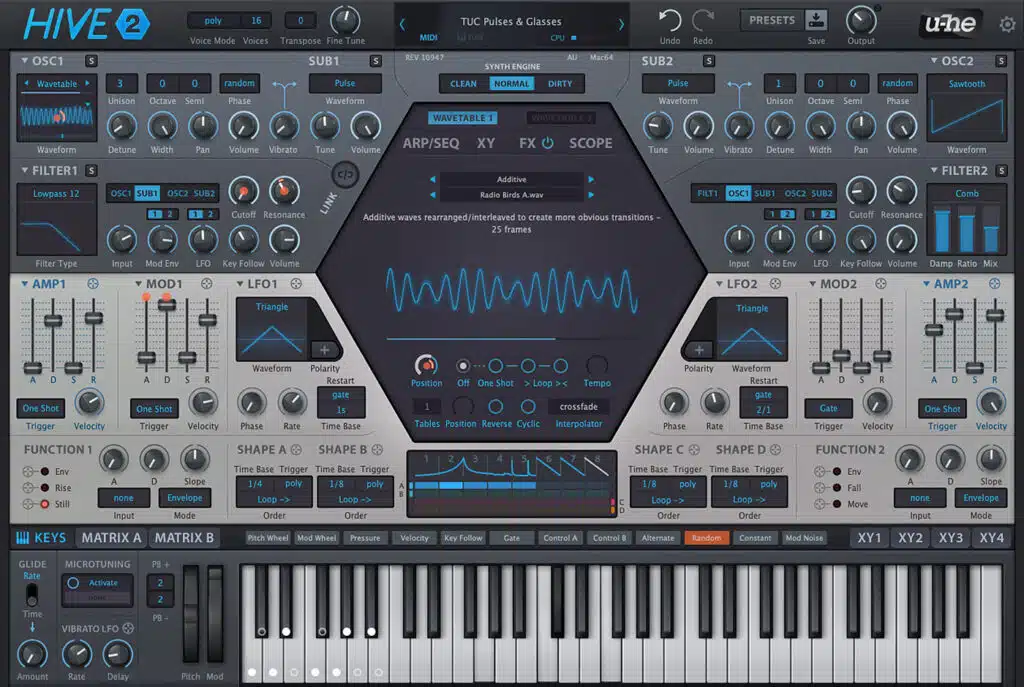
Subtractive synthesis is when you take a waveform to generate a wide range of harmonics through the use of an oscillator.
Then, the result is filtered to shape and sculpt the sound even further.
You will almost never want all the harmonics that the waveform generates.
Subtractive synthesis is the most popular form of synthesis when referring to actual Synthesizers.
It serves as the best tool to help break down the fundamentals.
U-he Hive, nicknamed “The Sylenth1 Killer” by many, is a more modern subtractive (software) VST synth.
Don’t get me wrong, Hive is certainly the most Sylenth1-like VST synth on the market today.
However, since the release of version 2, it outshines it in many aspects as well.
It has a similar vibe/layout and signal-flow as Sylenth1, and is just as user-friendly, but it feels more modern.
There are also more layers to pull back when ready, or if desired (which we highly recommend).
Plus, It’s also updated regularly; the developers are always adding new features consistently.
On the flipside, when it comes to Sylenth1, it has only dropped a few, minor updates since its initial release.
So, saying people were hungry for a v2 is an understatement. They left us starving.
That is why we have chosen Hive as the superior synth over Sylenth1.
HIVE: FEATURES & FUNCTIONALITY
Hive contains two oscillators, with a heavy inclination towards dance music and EDM production.
It’s not exactly as warm (or analog-ish) as Sylenth1, as it gives off a more digital, punchy sound.
This is why it’s ideal for electronic music genres.
In the very center of the interface is a huge hexagon.
- The left side 一 contains the first oscillator, filter, LFO, amp, and MOD envelopes.
- The right side 一 is identical to the left (and houses oscillator 2), with the same set of elements.
Featured within this hexagon is an awesome 16-step arpeggiator, as well as the Effects section.
THE ‘EFFECTS’ SECTION IS COMPRISED OF 7 EFFECT TYPES:
- Distortion
- Chorus
- Reverb
- Delay
- An Equalizer
- A Compressor
- A Phaser
HIVE’S OSCILLATORS CAN BE ANY ONE OF THE (TRADITIONAL) 9 WAVES:
- Sine
- Saw
- Triangle
- Pulse
- Square
- Half pulse
- Narrow pulse
- White Noise
- Pink Noise.
Located to the right of each oscillator, you will find an accompanying sub-oscillator with a 4-octave range.
The unique thing about Hive is, it has 3 Synth Engine Characters 一 Normal, Dirty, and Clean 一 near the top of the interface.
Each ‘character’ alters the feel of components (like envelopes and filters) which can instantly make a patch sound completely different.
Don’t forget to experiment with these distinct modes, as they’re just a toggle-switch away.
They can considerably change the entire feel of the preset you’re currently working in.
The MOD Matrix is located at the bottom of the interface, which gives you the ability to swap out/toggle between the Matrix and keyboard keys.
‘Drag & Drop’ functionality is implemented, which makes it simple to connect and experiment with different parameters you wish to modulate.
FX Presets (presets designated only for effects) are available, so you’re able to apply that effect configuration to any patch you’d like.
Hive comes equipped with 2700 presets to choose from 一 from sick modern dance leads to creepy atmospheric ambient pads.
There is also a super beneficial Undo/Redo function with 10 levels… which is something that Sylenth1 (and every other synth) could certainly use.
Hive is fast, simple, and encourages you to create sounds quickly.
It has a fluid, smooth workflow that lets you manipulate, tweak, and modulate in all the best ways.
Which is why it is our top-pick for subtractive VST synths.
PRICE: $149
TOP WAVETABLE VST SYNTH: SERUM BY XFER RECORDS
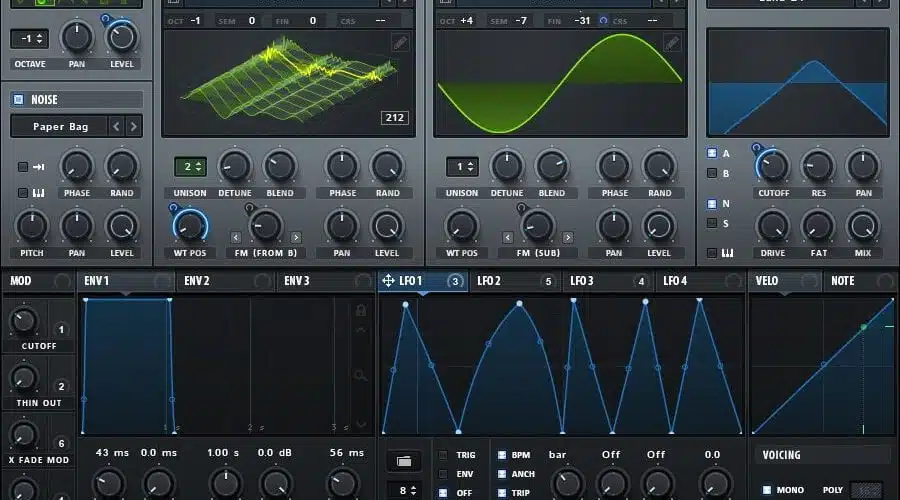
Thanks to the advent of digital wavetable synthesis technology, invented by the genius (and legend) Wolfgang Palm, wavetable synthesis is subtractive synthesis.
Except with one crucial difference…
Instead of your oscillators generating a static waveform, wavetables allow you to use/create any waveform you’d like.
Plus, by having multiple waveforms within each individual table, it gives you the ability to scan through them as well.
This enables you to create ‘morphing’ sounds that couldn’t otherwise be accomplished using a standard subtractive synth.
And the best part of all: you’re able to take any sample you’d like and create a wavetable out of it.
Truly revolutionary.
SERUM: FEATURES & FUNCTIONALITY
Serum is, without a doubt, the king of wavetable VST synth plugins.
While there are certainly other contenders, there is yet to be another plugin with the same power, stability, and flexibility as Serum.
For starters, Serum’s oscillators sound way cleaner than comparable synth plugins.
Just load up your favorite wavetable, from virtually any WT synth.
You’ll instantly hear why it’s superior to everything else on the market of its kind.
The oscillators were designed around the most advanced, high-quality wavetable engine around, possibly in existence.
There is also a static third oscillator in the form of a sub-generator, which can be transposed up/down by 4 octaves.
It generates the 6 standard subtractive waveforms.
- There is a 2D waveform view 一 default
- Clicking it reveals an unreal 3D wavetable display 一 indicates, and visually shows you the current wave cycle in relation to the rest of the waveforms within the table.
Warning, it comes at the expense of extra CPU.
You can import audio to create custom wavetables of your own.
Take it one step further and use Serum’s built-in, insanely powerful Wavetable Editor to modify and manipulate it in endless ways.
Satisfying even the most hardcore user.
Serum’s LFO is fully customizable and allows you to utilize it as if it were an Envelope.
It even doubles as a Step Sequencer.
Aside from the insanely beneficial (fully customizable) FX chain, which comes with every effect you could ever ask for, is its high-quality filters.
You can even take advantage of the Serum FX version that comes with the plugin.
This makes it possible to apply the effect chain, and all incorporated modulation on any element you’d like.
Meaning, you can essentially substitute Serum’s oscillator with your all-time favorite synth; creating a hybrid.
Serum will take care of the filters, modulation, and effects.
Another super cool feature of Serum is its Noise Generator which is, in reality, a Stereo Single-Sample Player.
It comes pre-loaded with every flavor of noise you’ll ever need, including:
- Basic white noise variations
- Output noise, sampled from classic hardware synths (plus additional alternatives)
- Attack samples (clicks, pops, percussion)
- A decent variety of additional samples/noises to be used as ‘texture.’
This noise generator is ideal when synthesizing percussion instruments. It can run looped, or in one-shot mode.
The Filter Module includes a wide variety of the normal analog-style models:
- Low-pass
- High-pass
- Band-pass
- Notch
Along with a plethora of other filter types, including:
- Comb filters
- Analog-inspired filters
- Flangers
- Phasers
- Scream filters, and a bunch of other unique filter-types
- Ring Modulation
- Formant Filter
- Sample and Hold (S&H) Filter
- Multi-filters (filters of different types; turning 1 filter into 2 within a series)
- Etc.
Similar to Massive, the modulation is accomplished by a drag-and-drop, with a 32-slot MOD Matrix.
You’re able to see everything in one place.
Plus, there are more advanced features, like user-editable curves.
As well as an auxiliary ‘via’ source, which works as a scale or sidechain function for each individual slot in the Matrix.
There are 3 AHDSR envelopes and 4 LFOs, which feature an envelope mode for building multi-stage (unlimited) envelopes.
Plus, 4 macros are in place for creating your own twisted parameter combinations, under unified control.
This is not just a desert island wavetable synth, it’s a desert island plugin period.
Don’t forget to check out our incredible free presets, which are part of Unison Serum Essentials.
Price: $189
TOP ADDITIVE VST SYNTH: RAZOR BY NATIVE INSTRUMENTS
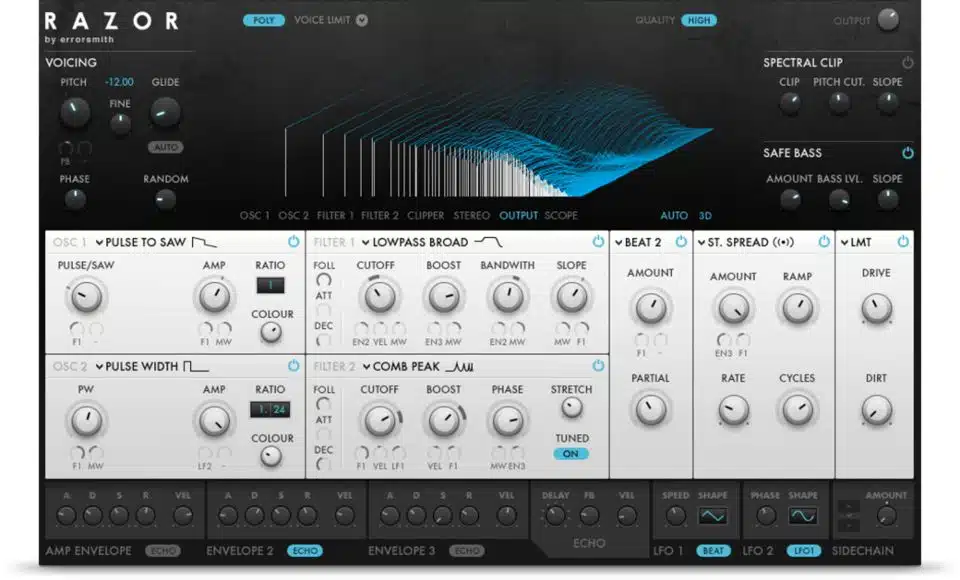
Additive synthesis is based on the fact that any audio signal in existence, regardless of its level of complexity, can be broken down into a series of sine waves.
This was first theorized by Joseph Fourier, and is known as FFT (Fast Fourier Transform).
While it started in audio, it now has a host of scientific applications, extending way beyond the audio realm.
It’s the technology behind Spectrum Analyzers.
With this knowledge, you can reproduce any waveform with the right combination of (individual) sine waves ‘partials.’
Pile up these partials (i.e., harmonics) at related harmonic integers at different amplitudes, and you get familiar waveforms.
It’s the overall amplitude and phase which determine much of the generated effect.
Everything you hear in Razor 一 the filters, stereo-imaging, reverbs, delays, etc. 一 is created by manipulating these individual sine waves.
Resulting in unique, quality sounds different from those produced with the use of traditional synthesis methods.
There you have additive synthesis in a nutshell.
Due to its complexity and sometimes unpredictable nature, it’s generally known to be the most complex synthesis type.
Today’s top pick for additive VST synths on the market is Razor (a Reaktor ensemble).
It has amazing sonic capabilities, an easy yet powerful modulation system, and unique modules that tweak the partials.
This creates a wide, seemingly endless variety of waveform and filter shapes.
As well as useful visualization of the partials themselves.
As well as sick dynamics and a precise sound identity that caters to tenses basses, bristling leads and shifting, sci-fi soundscapes.
Not to mention, it’s super affordable.
RAZOR: FEATURES & FUNCTIONALITY
Razor’s interface is super easy to grasp and use.
If you have any experience dealing with synthesizers, you’ll be able to start playing around with it right away.
The oscillator section has two different oscillators and offers a nice selection of unique oscillator types.
Aside from the traditional waveform types, like Sawtooth, there are additional (swappable) modules.
These enable you to generate ‘types’ that are super exotic (like Hoover).
Each oscillator type comes with a specific set of parameters (many unique to Razor) in addition to the standard volume, pitch, and equalizer controls.
The filter section features several low-pass filter types, along with some lesser-known variations.
The cool thing about this particular section is that, no matter how crazy you go with tweaking and manipulating different filter parameters, the results will always be super clean and usable.
There is also a 34-band vocoder that can be used to modulate the modules with any audio input signal.
RAZOR IS COMPRISED OF 2 EFFECTS SECTIONS:
- The first covers a range of various dissonance 一 this can be used to create non-harmonic sounds.
The included (6) dissonance effects are quite unique and create some pretty unusual timbres.
They are a perfect tool for creating dramatic, weird, otherworldly noises.
- The second covers more standard effects 一 such as chorus, delay, reverb, etc.
All effects are synthesized in real-time, unlike the regular effects, which can only alter sound after it leaves the source.
Instead of using a MOD Matrix, there is a Selecter Slot shown beneath each parameter, enabling you to quickly apply and edit modulation settings.
Razor comes equipped with over 500 presets as well, which are pretty epic.
There is a huge, fancy spectrum display at the top of the interface.
It shows you the precise representation of a given sound’s harmonic content in each synthesis stage.
This is great for creating sounds that will easily fit into a specific mix.
Another noteworthy feature is the Safe Bass generator.
Its purpose is to add additional spectral content to the fundamental frequency and ensure that bass sounds remain ‘musical’ and present.
Even if you abuse the hell out of them.
It has an option to be turned off, in case you’re making sounds that don’t really require a strong bass/fundamental frequency layer.
Similar to LP Filters, Razor includes a saturation module and a Spectral Clip unit that limits the frequency spectrum.
Overall, Razor is an amazing option to check out, even if you’re just starting out on your beat-making journey.
PRICE: $99
TOP FM VST SYNTH: FM8 BY NATIVE INSTRUMENTS
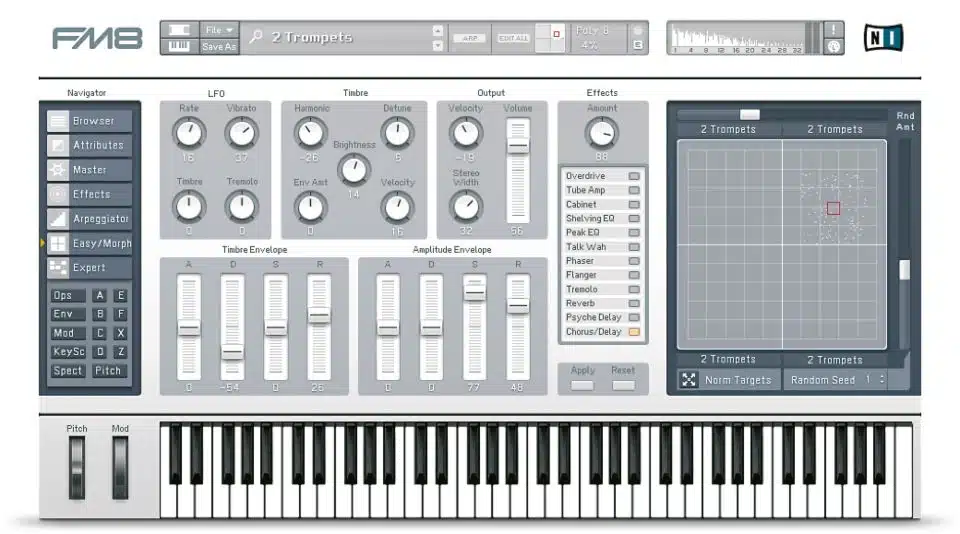
FM synthesis is, like additive synthesis, regarded as one of the most complex synth types out there.
But don’t get me wrong, whereas the two might seem similar in essence 一 combining sine waves in order to generate new waveforms and sounds 一 they are very different.
It’s the way you combine said waves and generate/synthesize sounds, as well as the sounds themselves that makes FM synthesis very unique.
It has a signature sound that is instantly recognizable.
Think of Skrillexs’ synth sounds… you can usually hear some form of FM synth in his music.
“I use Live’s FM synthesizer a lot in most of my music” 一 Skrillex
FM is built mostly on the concept of using sine waves to synthesize an output.
However, instead of adding and summing these sine waves together at various frequencies, phases, and amplitudes, you take the sine waves and modulate them with one another using complex math.
In turn, this creates harmonic multiples of the waves you’re modulating (sidebands) to generate the output.
This results in a super unique sound that FM is known for.
FM8: FEATURES & FUNCTIONALITY
FM has excellent sound quality, the best FM Matrix in the game, and awesome presets.
It even has features not seen on typical FM VST synths, like its wide array of filter options.
It still encompasses all of the features that made the original FM7 stand apart from the rest.
But this time around, it has a more powerful (user-friendly) interface.
Not to mention cleaner and clearer.
FM8 offers 32 types of different waveforms, which makes its sonic palette super wide; this is where the true strengths lie.
You can utilize one or more of these (6) operators to modulate any, or all of the others in order to create new, unique sounds.
There are also many more potential algorithms to work with, via the FM Matrix.
Another bonus is that FM8’s operators, as opposed to the DX7, are not limited to sine waves.
You can choose from any of the 32 waveform types that are included.
The Effects page is definitely worth mentioning as well.
All the typical options are available, along with some complete amp cabinet simulations.
There are 12 effects and 960 pretty dope presets.
The bottom half of the navigator is found with the Expert page, where you can access the actual operators themselves.
You can switch between operators by clicking the ‘A to Z’ buttons in the Matrix display.
THIS IS ALSO WHERE YOU CAN FIND:
- 32-stage Envelopes
- Key scaling
- Spectrum display
- MOD Matrix
- LFOs
- AND MORE
FM8’s Morph section is completely one-of-a-kind, as you can take multiple presets and morph between their parameters in real time.
If you’re not into programming your own presets, you’re going to love this section especially.
You’ll also have a blast controlling the Morph grid with the knobs found on your MIDI controller.
Here, existing presets can be dragged and dropped onto the square (top).
You can assign various patches to each of the 4 corners, and crossfade among them.
This will create timbres that change over time.
If you’re in the market for FM, this should be your top pick.
Simply set up a (complex) array of operators, incorporate some unison, throw on a couple of effects, and you’ll truly be in FM heaven.
Plus, aside from FM, it can also be utilized as a typical subtractive VST synth, and perform additive synthesis duties in its most basic form.
PRICE: $149
TOP GRANULAR/SAMPLE-BASED VST SYNTH: PIGMENTS 3.5 BY ARTURIA
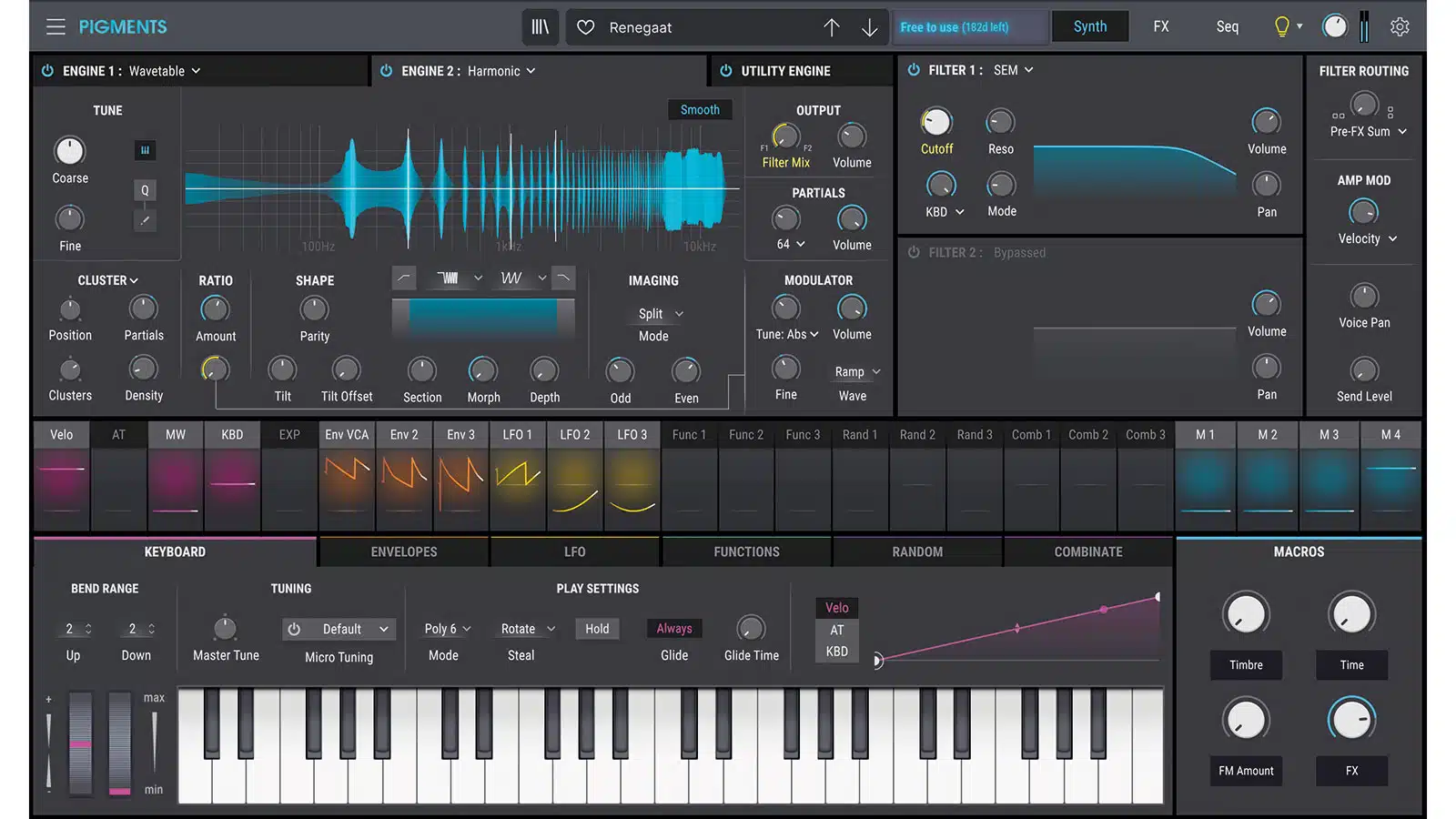
Granular synthesis as a whole is rather broad and unspecific, as it can technically cover all systems that utilize the ‘granulation’ concept.
Granulation is a process where audio samples are broken down into tiny audio segments, known as ‘grains.’
A grain typically ranges from 1-100 milliseconds in length.
Each individual grain, along with their overall arrangement can be tweaked as needed.
When you play back these grains in different orders/patterns, they can be:
- Looped
- Layered
- Omitted
- Skipped Over
- Etc.
The possibilities are endless, and the results are truly awesome.
The supreme VST synth plugin in this category has to go to Pigments 3.5.
Since it’s release (in 2018), Arturia’s Pigments made its immediate mark in the VST synth plugin game.
The new release of Pigments 3.5 (and its new additive engine) has impressed us even more.
PIGMENTS 3.5: FEATURES & FUNCTIONALITY
To start off, Pigments 3.5 offers an evolved synth spectrum and introduces various (noteworthy) new features, including:
- Cross-modulation between engines 1 & 2 一 use either mod source
- Customizable parameters 一 create insane harmonics, unique waveforms, and extreme sonic results
- New distortion module 一 offers you 16 modes with built-in filtering and an expanded comb filter
- New wavetables 一 inspired by everything from molecular structures to modern timbres
- Enhanced sample engine browser 一 offers subfolders & one-click sample previews
- Upgraded interface 一 streamlined slightly to speed up workflow
It also has an additive oscillator on top of its existing FM and PM (Phase Modulation) functionality.
This gives you the ability to modulate a synth oscillator with your samples, granular synth with your additive synth, and everything in between.
Pigments 3.5 comes equipped with 150 new factory presets, on top of its humongous stock library, designed to emphasize these new features.
There are also 3 new add-on preset packs, straight from Arturia’s built-in preset store browser, with over 150 patches each.
- Bass Thermal
- EDM Kinetic
- Trap Chemical
Pigments 3.5 makes crafting modern sounds with complex modulations easy as can be, not to mention quick and fun.
It delivers modern, avant-garde sounds, features, and playability.
Not to mention its super dope sonic prowess.
It is a groundbreaking, must-have VST synth plugin for producers, sound designers, synth lovers, and everybody in between.
PRICE: $99
TOP ALL-IN-ONE VST SYNTH: OMNISPHERE 2.8 BY SPECTRASONICS
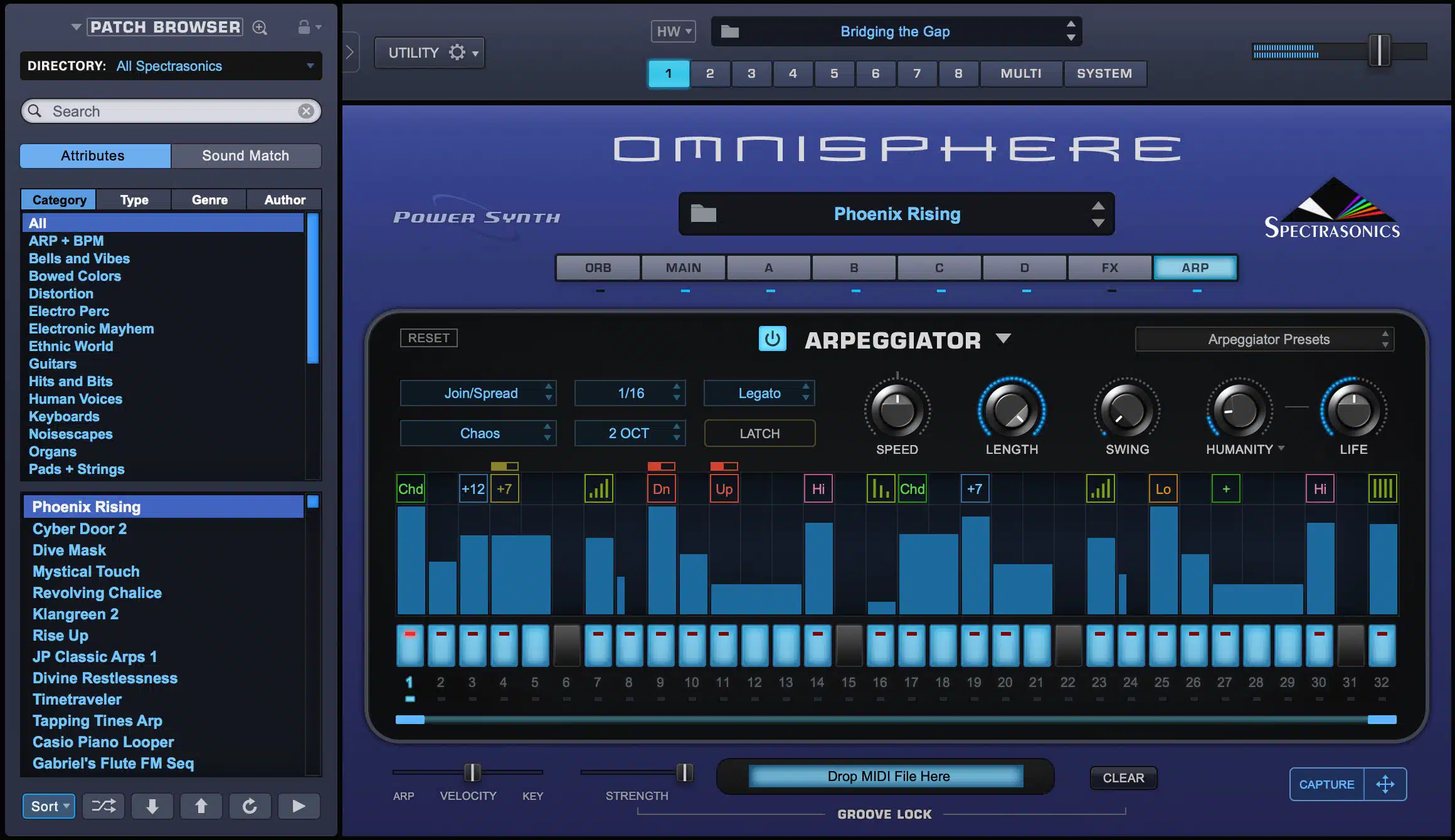
When referring to an all-in-one VST synth, that simply means it contains multiple synthesis types (such as the ones described above).
To qualify, it must function as a sampler, and typically offers a vast sound library.
This one was a tough decision to make.
It was a pretty even toss-up between Omnisphere 2 and Reaktor, but since we’ve already included Razor, we’re giving this one to Omnisphere 2.
Another reason being, while Reaktor is expandable (similar to Omnisphere) it offers much less in terms of content and power.
Its price of admission doesn’t even include the Reaktor ensembles that you’re really looking for (like Razor).
Omnisphere is the supreme, more cost effective choice, making it today’s top pick.
OMNISPHERE 2.8: FEATURES & FUNCTIONALITY
Omnisphere is a super powerful, and versatile VST synth.
Plus, it can certainly serve as an essential source of sonic inspiration as well.
It is the only software synth in the entire world that offers in-depth Hardware Synth Integration features.
Even supporting most of the lesser-known, least used hardware synths.
This transforms over 65 popular hardware synths into extensive hands-on controllers, which unlocks Omnisphere’s newly expanded (hands-on) functionalities.
Each individual hardware profile has an associated sound set designed with the use of that specific hardware synth as an Omnisphere controller.
Essentially, it functions like a hardware synth. It’s super awesome.
You can definitely enhance your mix with this VST synth.
Omnisphere 2.8 supports a newly redesigned, high resolution interface, with support for HiDPI displays.
The modernized GUI is easier to use, beginner-friendly, and resizable to fit comfortably into your personal workspace.
In addition, it has a killer IOS controller app that lets you manipulate some of its coolest features wirelessly.
Omnisphere 2.8’s new Library contains over 1600 new patches to experiment with.
You can now also incorporate your own audio files as a sound-source within Omnisphere by simply dragging & dropping.
IT’S EXPANDED NEW SYNTH ENGINE INCLUDES:
- Countless synth types
- 4 layers/patch
- New state variable filters
- Over 500 DSP wavetables
- Powerful granular synth
- 8 LFOs
- 12 ENVs
- 34 filter types per part
- Doubled MOD Matrix
- Full FX Modulation
It now includes over 58 FX Units, with fully adjustable FX chains so you can order the effects however you’d like.
As well as 14,000 sounds and new expansion products, called Sonic Extensions.
It extends its capabilities with special features, effets, and sounds that are constantly being added, updated, and refined.
They fix any bugs as soon as they fly by.
Due to these amazing features and functions, we’ve placed it at the top of today’s list in this category.
PRICE:
Omnisphere 2 full product download: $499
Standard upgrade FROM V1: $249
TOP ANALOG-EMULATION VST SYNTH: DIVA BY U-HE
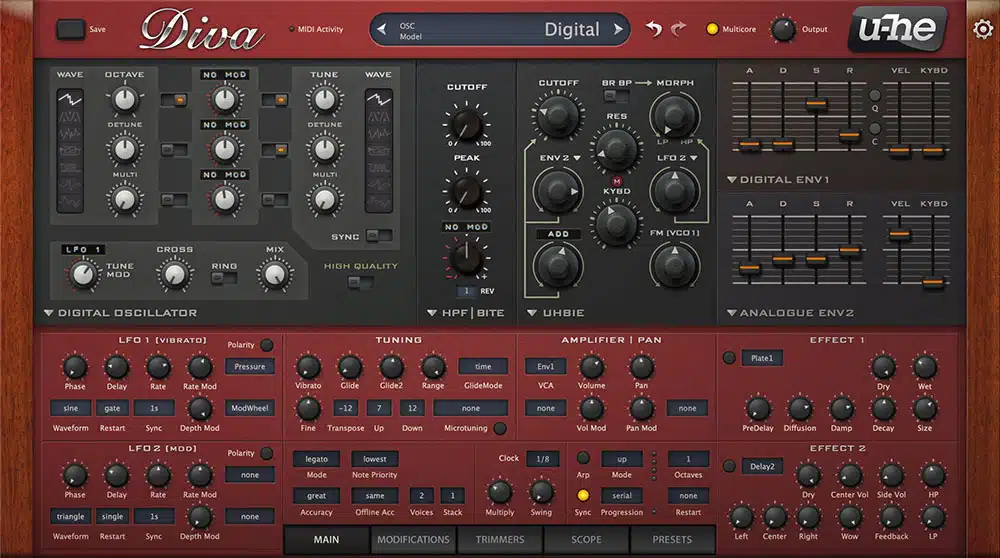
While there are a ton of incredible analog-emulation VST synth plugins, Diva (Dinosaur Impersonating Virtual Analog Synthesizer) is easily the top pick in this category.
It draws its inspiration from multiple classic hardware synths, and lets you mix and match.
This is done by swapping each of its (multiple) included filter, oscillator, and even envelope-types/styles; modeled off of specific classic hardware synths.
Diva will also give you unmatched control over virtually anything it generates.
You’ll have some unique, intricate options when it comes to manipulating and altering certain parameters.
Whether it be existing modules, modulators, built-in effects, and/or overall utilities.
Not to mention, it lets you micro-tune and alter the settings of each individual voice, using the dedicated ‘Trimmer’ page.
This is accomplished on such a precise level, it’s no wonder u-he is so highly regarded.
It is praised by both professionals and amateurs alike.
Since its release, it has quickly become an industry favorite as well.
Even Hans Zimmer prefers u-he products over any major developer… yes, including Diva itself.
Since Diva lives in ‘the spirit of analog,’ it’s a subtractive-based VST synth with some FM functionality, which is inspired by the analog domain.
This is super rare in itself, and almost impossible to pull off, so kudos to Diva.
Granted, It’s not too big on the modulation side of things.
However, the beautiful sound it generates is so authentic, you might immediately throw all your other analog-emulations in the trash.
No wonder its sound is award-winning.
Unlike Hive, however, it does use a lot of CPU…
But that’s to be expected when dealing with any good emulation that’s equipped with a modern analog-modeling engine of any kind; instrument or effect.
So, regardless of that fact, it is still the top-pick for analog-modeled VST synths, hands-down.
DIVA: FEATURES & FUNCTIONALITY
Diva has an absolutely beautiful UI… but it could be overwhelming at first if you’ve never had experience with physical hardware before.
For instance, the modulation section, compared to something like Serum, is way less intuitive.
However, within a few hours, you’ll get the hang of it, no problem.
Your patience will be rewarded tenfold, if not more, based on just the results alone.
If you come from a hardware background, you’ll instantly be comfortable with Diva’s layout.
It’s modelled off classic analog hardware synth modules.
Over 5 decades of them, to be exact.
One of the features that sets Diva apart from everything else on the market is its superior-sounding filters and envelopes.
What gives it an unmatched analog sound is the technology behind u-he’s analog modeling.
It accurately replicates how hardware synth filters react with waveforms.
The waveforms themselves, and all other non-linearities you know and love are what makes analog what it is.
Meaning, this allows Diva to have real time circuit simulation.
This produces a more authentic resonance, and phase behavior that analog synths have when generating sound using voltage.
It also causes other factors, such as slight, random changes in wave shapes.
Diva allows you to replicate this natural drift with the help of its Oscillator Voice Detune section.
This ultimately lets you control just how ‘analog’ you wish your synth to sound.
When it comes to presets, the variety is mindblowing (to say the least), and the preset browser is super easy to use.
There is an endless number of free packs and presets available online, thanks to its avid, dedicated user-base.
There are also stock patches already included for any, and every situation.
With options guaranteed to fit perfectly within your tracks… even without tweaking or manipulating them at all.
As you flip through, they will truly make your jaw hit the floor as you think about the sound design possibilities.
You can even ‘favorite’ certain patches with different color codes, which helps speed things up so you don’t lose any inspiration.
When it comes to oscillators, you can mix and match them…
THIS OSC MODULES AVAILABLE INCLUDES:
- A triple VCO oscillator module (Minimoog)
- DCO module (Roland Alpha Juno)
- 2 dual VCO modules (Jupiter 8 & 6)
- Digital wavetable module (Roland JP-8000)
THERE ARE ALSO CLASSIC FILTER EFFECTS TO CHOOSE FROM, LIKE:
- A Moog ladder filter
- Cascade filter
- Multimode filter
- Bite filter
- UHBIE
- Extra high-pass filter effects
To put the cherry on top, there are also 3 different envelope-types; each modeling a different synth’s envelope characteristics.
The effects found within Diva are pretty standard (phasers, chorus, delay, plate reverb, rotary effects).
They are analog-modeled to perfection.
So, like everything else in this plugin, you can bet your bottom dollar they will sound way better than your usual plugin option/choices.
The especially unique thing about the included effects is the ability to alter algorithms.
For example, you can change the transient mode.
This will give you some mind-blowing results in clarity and the responses of your synth patches.
You can even change the scale to reach scales that aren’t in the traditional (western) 12 tones you’re used to.
WIth its unmatched sound, combined with the simplicity of its GUI, your workflow will thank you for this one, no questions about it.
PRICE: $179
FINAL THOUGHTS
When purchasing a new synth, it can be overwhelming due to the endless choices.
This is why it’s best to first determine the synthesis type you’re looking for.
Make sure to factor in what you know, wish to learn, have the time to figure out, and what your ultimate goal is.
Also, what will compliment (and benefit) your workflow the most as well.
Once you determine the synth type, you can’t go wrong with the top-licks listed in today’s article.
When creating sounds from the ground up, it’s less about the synth itself, and more about your knowledge of, and how you manipulate it.
Remember, a synthesizer doesn’t make up every element in your track…
For example, rhythmic sections aren’t exactly a synth’s strong suit, and you’ll need them to really pop in order to stand out.
To level-up your drum game and make your tracks instantly addictive, download Unison Essential Drum Loops.
They contain professional-quality drum loops that are mixed to perfection and will blow the minds of your audience.
Simply plug & play them straight into your tracks.
You can even use them with all your favorite samples!
Until next time…






